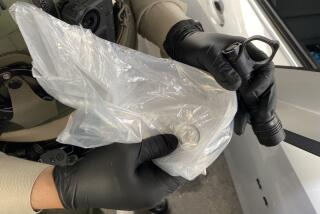Tracking Devices Found Useful in Monitoring Offenders
- Share via
WASHINGTON — Two years of successful experience in 20 states has increased the interest of law enforcement agencies in the use of electronic tracking devices to check on the movements of parolees, probationers and individuals awaiting trial for minor offenses, a Justice Department agency reported Sunday.
James K. Stewart, director of the National Institute of Justice, said monitoring devices that vary according to the degree of supervision required have been used in 45 programs involving 900 individuals. He said they all have “the ability to improve operations at a moderate cost by verifying that those under official supervision really are where they are supposed to be.”
“These programs are not intrusive, nor do they permit eavesdropping,” Stewart said. “They do not record private conversations or otherwise intrude into people’s privacy. They merely verify that people being monitored are within a range of the receiver-dialer--that is, at home, at work or some other appropriate location.”
Most in Two States
Most of the programs are in two states, Florida and Oregon, the institute reported, and only 14 involve supervision of 20 or more individuals, while 19 affect fewer than five.
A majority of the equipment relies on bands riveted around the wrist or ankle of the individual under supervision that carry devices for transmission to computers of electronic signals that vary according to the requirements of individual programs.
Some programs use continuous signals between the band and a receiver in the individual’s home or workplace. The signals stop if the wearer leaves a designated area, and a central computer is notified of the interruption. In other instances, the devices can be used to monitor an individual’s schedule, automatically notifying a program’s supervisors if a curfew is violated.
With other equipment, telephone calls are placed to the person being monitored, either on a set schedule or at random, and results are recorded. Some devices use a verification machine to ensure that the voice answering the phone is that of the person being monitored. Others require the individual to wear a wrist band programmed with a numerical code that can be verified with a touch-tone telephone.
Plastic Box on Wrist
A third variety uses a small plastic box riveted around the wrist that is inserted into a verifier device attached to a particular telephone to give positive identification of the person responding to a checkup call.
In another approach, some programs use paging devices and require the person under supervision to call back whenever paged. The responses are recorded for verification.
The programs have been used for supervision of juveniles as well as adults, most of whom are charged with misdemeanors, frequently with traffic violations. Most of the programs exclude felons, and all such programs exclude those charged with serious or violent crimes.
More to Read
Sign up for Essential California
The most important California stories and recommendations in your inbox every morning.
You may occasionally receive promotional content from the Los Angeles Times.










